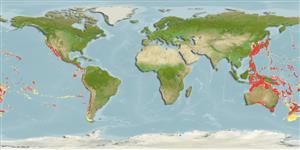分類 / Names
共通名の | 類義語 | Catalog of Fishes(部類, 種) | ITIS | CoL | WoRMS | Cloffa
板鰓亜鋼(サメとエイ類) (sharks and rays) >
Echinorhiniformes (Bramble sharks) >
Echinorhinidae (Bramble sharks)
Etymology: Echinorhinus: echinos (Gr.), spiny or sea urchin, referring to thorn-like denticles (brambles) on body; rhinus, an ancient name for sharks, from rhine (Gr.), rasp, alluding to a shark’s jagged, rasp-like skin. (See ETYFish); cookei: In honor of the “distinguished conchologist” Charles Montague Cook, Jr. (1874-1948), Bishop Museum (Honolulu), for his “helpful assistance” with Pietschmann’s work (per Pietschmann 1930). (See ETYFish).
Environment: milieu / climate zone / depth range / distribution range
生態学
海 底生の漂泳性; 深さの範囲 11 - 1100 m (Ref. 26346), usually 70 - ? m (Ref. 6871). Subtropical; 47°N - 55°S, 119°E - 68°W (Ref. 54428)
Western Pacific: Japan (Ref. 6871), Taiwan, Palau, Australia (Ref. 6871) and New Zealand. Eastern Pacific: Hawaii, USA, Gulf of California, and from Costa Rica to Peru and Chile (Ref. 13564). Also reported in Nicaragua (Ref. 13613).
Length at first maturity / サイズ / 重さ / 年齢
Maturity: Lm 275.0, range 250 - 300 cm
Max length : 400 cm TL オス/雌雄の選別がない; (Ref. 247)
背面の脊椎 (合計) : 0; 肛門の骨: 0; 脊つい: 89. The prickly shark Echinorhinus cookei has thorn-like denticles on body which are moderately large (single denticles up to about 4mm in basal diameter in adults), numerous, regularly distributed, with scalloped basal margins, and never fused into compound plates. Grayish brown in color, with black distal fin margins; white around mouth and on ventral surface of snout. Tooth count 21-23/20-22. Total vertebrae 89; precaudal 59. As with the other member of the family Echinorhinidae, it has a relatively short snout and stout body; two small spineless dorsal fins, close together, towards posterior part of body and originating behind pelvic fin origin. No anal fin and subterminal notch on caudal fin. Small spiracles, very short labial furrows and teeth on both jaws alike, with a central oblique bladelike cusps with up to 3 cusplets on each side (absent in juveniles) (Ref. 247, 6871).
A large, sluggish shark occurring on continental and insular shelves and upper slopes (Ref. 247). Feeds on a variety of fishes, other sharks, octopi and squids (Ref. 13564). Ovoviviparous (Ref. 205), with up to 114 in a litter (Ref. 26346).
Presumably ovoviviparous (Ref. 6871) with up to 114 in a litter (Ref. 26346).Distinct pairing with embrace (Ref. 205). Size at birth 40-45 cm. Some males mature by 198 cm; females mature between 250 and 300 cm (Ref. 6871).
Compagno, L.J.V., 1984. FAO Species Catalogue. Vol. 4. Sharks of the world. An annotated and illustrated catalogue of shark species known to date. Part 1 - Hexanchiformes to Lamniformes. FAO Fish. Synop. 125(4/1):1-249. Rome, FAO. (Ref. 247)
Human uses
水産業: 少数商業の
用具
特記事項
XMLをダウンロードして下さい
インターネットの情報源
Estimates based on models
Preferred temperature (Ref.
123201): 3.8 - 19.5, mean 12.1 °C (based on 522 cells).
Phylogenetic diversity index (Ref.
82804): PD
50 = 1.0000 [Uniqueness, from 0.5 = low to 2.0 = high].
Bayesian length-weight: a=0.00363 (0.00139 - 0.00949), b=3.13 (2.90 - 3.36), in cm total length, based on LWR estimates for this (Sub)family-body shape (Ref.
93245).
栄養段階 (Ref.
69278): 4.4 ±0.76 se; based on food items.
回復力 (Ref.
120179): 低い, 4.5年~14年の倍増期間の最小個体群 (Fec assumed to be <100).
Fishing Vulnerability (Ref.
59153): Very high vulnerability (90 of 100).
Nutrients (Ref.
124155): Calcium = 6.19 [1.46, 29.11] mg/100g; Iron = 0.439 [0.108, 1.332] mg/100g; Protein = 19.7 [17.9, 21.5] %; Omega3 = 0.244 [0.092, 0.736] g/100g; Selenium = 56.1 [16.6, 203.8] μg/100g; VitaminA = 10 [3, 45] μg/100g; Zinc = 0.382 [0.183, 0.729] mg/100g (wet weight);
